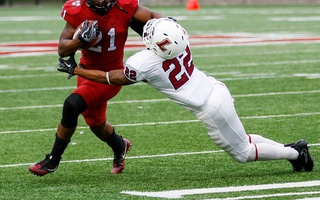On any Harvard tour, you’ll hear the tour guide proclaim how the University has led the country for centuries, and when you walk by the stadium, how we led the way in setting the rules for college football.
The sport was a bloody sport in its infancy. Players were protected by little more than leather caps, and the game very much resembled rugby. The sport was so rough that in 1905, at least eighteen players died from its injuries.
The ruthlessness got it banned from several colleges, and former President Charles W. Eliot, Class of 1853, called for the game to be changed or removed from the athletics program. Even Harvard alumnus and U.S. President Theodore Roosevelt, Class of 1880, called for reforms to the game.
To these calls, a series of changes were proposed that included widening the field by forty yards in order to avoid some of those deadly collisions. But we’d just built a new stadium for it! Instead of accepting someone else’s changes, we proposed and adopted the forward pass. Other schools followed, and the rest is history.
It’s been more than a century since then, and though the pads and helmets have evolved, the game has not gotten all that much safer. According to a study conducted between 1990 and 2010, each year, approximately a dozen or so football players across the country die and many more were seriously injured.
Just this year, a student in my own Class of 2021 took the field for the first time as a Harvard football player, only to have his season and life irreversibly changed. Ben M. Abercrombie ’21, a promising young athlete from Alabama, has spent the last five months recovering because of a neck injury that left him paralyzed.
Down in my home state of Florida, a defensive back for the University of Miami, Malek Young, suffered a career-ending injury to his neck as well.
These players put their health, their education, and their lives on the line of scrimmage seventy times a game, for half the year, but it’s not the even big hits that scare me the most.
It’s the small stuff that’s most worrisome. Not the guys getting laid out on the field by a bone-crushing tackle, but the snap after snap after snap that linemen and others endure. Seventy times a game, college football players crash heads, and the click and slap of shoulder-pads against helmets and of plastic hitting plastic echo throughout the stadium. The hits take a toll.
In one recent study of 202 former football players’ brains, more than 99 percent of NFL players, 91 percent of college players, and 21 percent of high school players were diagnosed with chronic traumatic encephalopathy—brain damage caused by repetitive blunt force trauma that has been linked to memory loss, depression, and dementia, among other things.
This isn’t new science.
It’s been highlighted in newspapers, on television, and in movies, but we make the choice to ignore it at the cost of more and more players developing the disease every year. We’re so obsessed with the hits that any top-rate broadcast features a satellite microphone on the sidelines designed to pick up each and every one of those crunches.
The harder the hit, the greater the amazement. It’s nothing short of watching gladiators smash each others’ skulls in from the stands of the Coliseum. It’s the stuff that draws people in, it’s the stuff that gets people watching, and it’s what’s killing these players.
I’ve loved football my entire life. Growing up in Miami, I went to Miami Hurricanes games with my father, and I still watch them play on Saturdays. But it’s not fair. Not to the players, not to their families, and not to the generations of athletes who are just now putting on helmets they’ll don for years to come.
All sports have some determined level of risks, but none has the rampant issues that football does. It’s ripe time that Harvard suits up for the title it bears so proudly—the greatest university in the world—and takes a stand for the future of student athletes.
Colleges and universities are places where students go to learn and grow, and sports that have been demonstrated to adversely affect the neurological development of young adults have no place in the halls of higher education.
It’s time for us to call for much-needed revisions to the sport, to change the rules, and to ensure that the game is played as safely as possible. Anything else is gross negligence and a dereliction of the duty of educating. Harvard can and should come out on this first. It might not be what’s easy or profitable, but it’s what’s right.
And that’s called leadership.
Patrick C. Barham ’21 lives in Pennypacker Hall.
Read more in Opinion
All Work, No PayRecommended Articles
-
John YovicsinThe life of a football coach is ideal, any red-blooded American will agree. In the most competitive of leagues, Alabama's
-
What About Spring Football Drills?Humbly, with little more than a lone Crimson reporter watching, the tradition of spring football practice began at the University
-
Rugby Team Kicks Off Tour of EnglandThe Harvard rugby team left for a week-long tour in England last night. Their first match will be on Thursday
-
Harvard Football: Which Way Out?This article has not been written because of outside pressure; it has been written because of the authors' conviction that
-
 Texas Players are Used to Bright Lights
Texas Players are Used to Bright Lights













